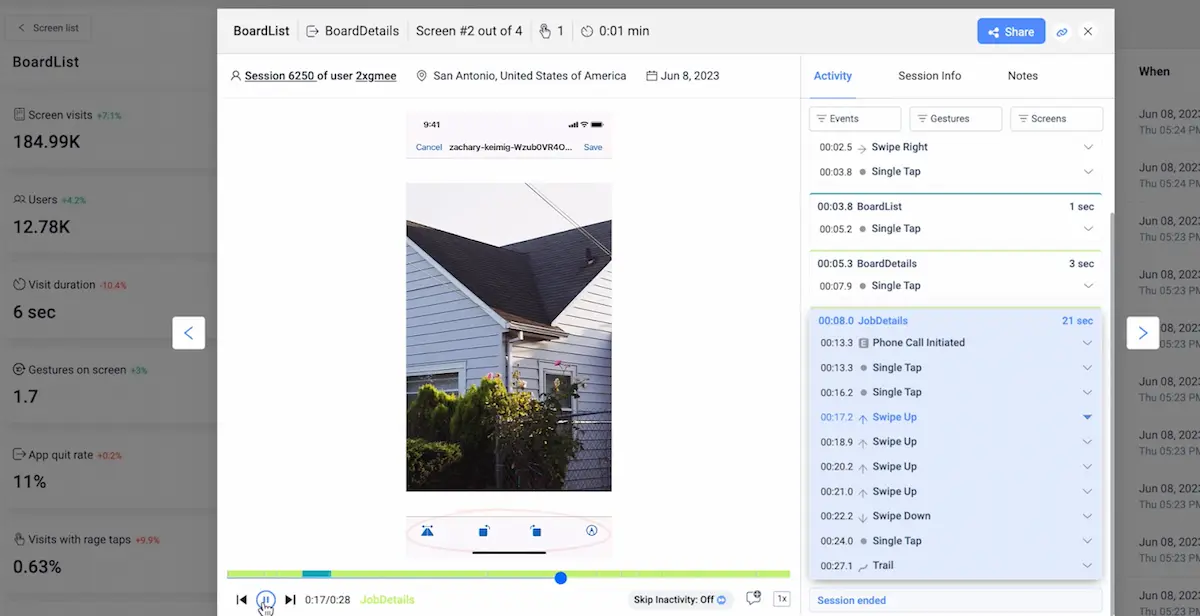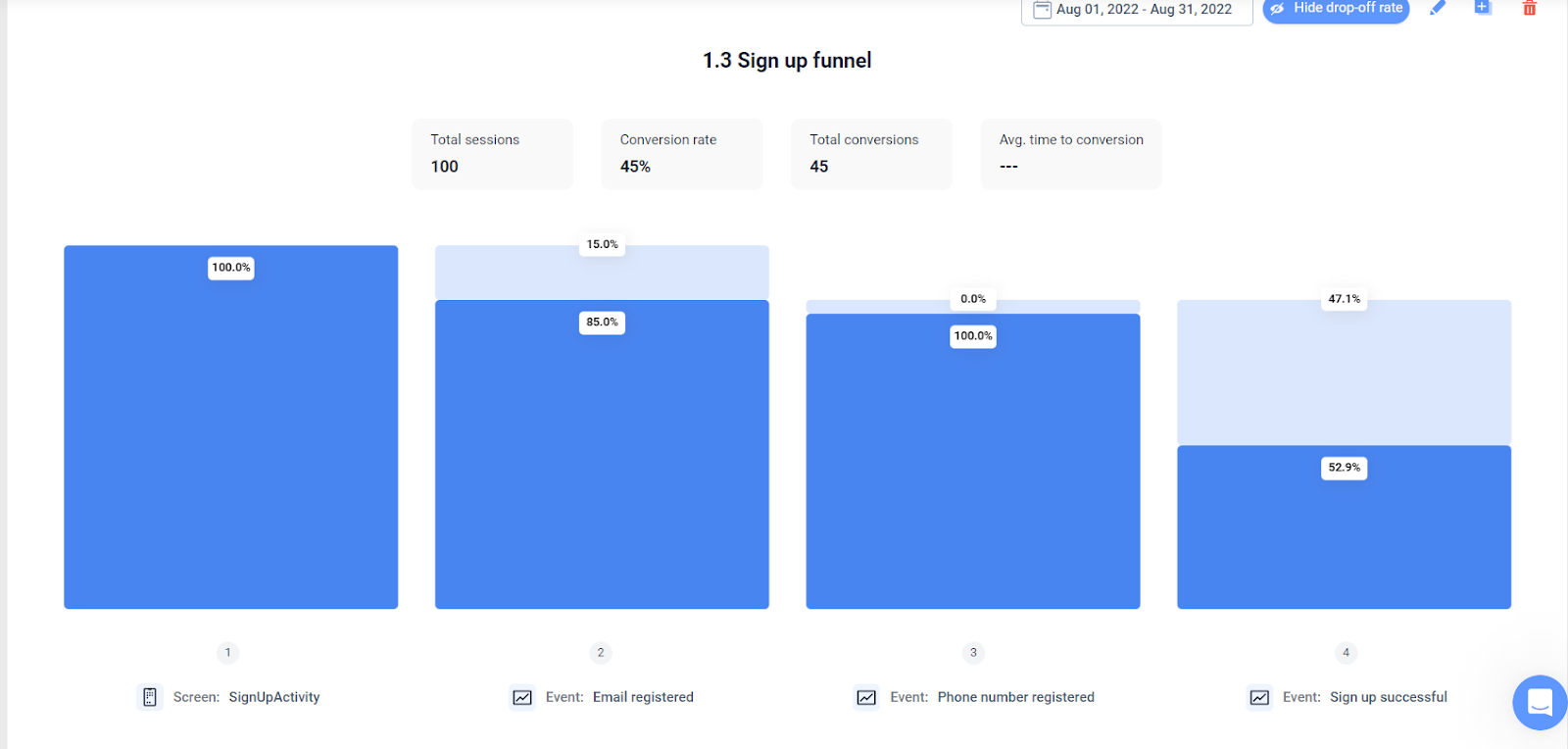Back to blog
7 MIN READ
Strategic Product Planning - How To Go From Prototype to Launch
PUBLISHED
14 December, 2023

Product Analytics Expert
Product development is a tricky process to navigate. According to a study by ZipDo, 66% of product development projects end in failure or experience significant delays. To avoid this fate, it's important to have a clear purpose and a well-defined plan to ensure the success of the product.
At UXCam, we've helped thousands of product teams take a data-driven approach to product planning. In this guide, we will explore the world of product planning and some tips on how to ensure success.
Let’s get started.
What is product planning?
Product planning is the process of product development and management that involves defining and strategizing to create a successful product.
It encompasses the activities required to identify market needs, set product goals, prioritize features, and create a roadmap for product development. And all of these activities rely on one thing above all else—data.

For an example of the product planning process in action, consider Inspire Fitness.
The product team at Inspire Fitness wanted to make data-driven decisions on what content to push out next and evaluate how their instructors were doing. They used UXCam’s event analytics and session replays to see what content and features were (and weren’t) resonating with users. This data let the team add items to their product roadmap with confidence, knowing they would lead to a better, more engaging product.
The result was a 460% increase in time spent in-app.

Why is product planning important?
Solve real problems
Product planning helps mobile app development teams identify the real problems that their target audience faces. By understanding the needs and preferences of their target audience, teams can create products that solve real problems.
According to a study by Forbes, 42% of startups fail because they do not solve a real problem. It's essential to identify the real issues that your target audience faces to create a successful product.
Align teams
Product planning helps align mobile app development teams toward a common goal. By creating a shared understanding of the product’s purpose, teams can work together towards a common goal.
According to a study by McChrystal Group, 97% of employees and executives agree that a lack of alignment within a team impacts the outcome of a task or project.
Make informed decisions
Product planning helps mobile app development teams make informed decisions.
By gathering relevant information and data, teams can make informed decisions about the product’s features, design, and development. A study by Harvard Business Review, found that businesses that make data-driven decisions are 5% more productive and 6% more profitable than their competitors.
How to do product planning effectively
Conduct research
Identify must-have features and build a roadmap
Set clear objectives
Launch and monitor your MVP
Prioritize fixes and new features to add to the roadmap
Iterate and add value to the product
Step 1 - Conduct research
According to a study by Forbes, 90% of startups fail due to a lack of market need. That’s a big, scary number—but it’s usually avoidable if you research carefully. That’s why the first step in the product planning process is researching your target users and the competitors that are already serving them.
Competitor analysis involves studying other mobile apps in the same industry or niche to understand what features they offer, how they engage with users, and what sets them apart from the competition. Test products out and read up on user reviews using sites like G2, Google Play, and App Store.
Market research involves gathering data on the target audience, including:
Preferences
Demographics
Behavior patterns
Industry trends
The goal is to get a preliminary idea of who you’re building your product for.
Step 2 - Identify must-have features and build a roadmap
Identifying must-have features helps mobile app development teams prioritize features based on their importance and relevance to the target audience.
JobNimbus used UXCam to track adoption rates and user interactions with the Kanban Board feature of their mobile app. By leveraging session recordings and adoption percentage data from UXCam, they were able to make informed decisions about the feature's success and prioritize their product roadmap more effectively.

The initial plan was to release a basic version of the Kanban Board feature and later release an improved version. However, by monitoring the adoption rate through UXCam, they noticed a significant increase in the adoption rate from 0.51% to over 25% within 4 weeks. Additionally, they were able to observe how users interacted with the feature through session recordings.
Based on these insights from UXCam, JobNimbus made the decision that it was no longer essential to build a whole other version of the feature, saving two months of work and better prioritizing their product releases.
Step 3 - Set clear objectives
Setting clear objectives is another essential criterion for successful product planning. It helps mobile app development teams define the purpose of the product and what they want to achieve. According to a study by Harvard Business Review, businesses that set clear objectives are 4.2 times more likely to achieve their goals.
Examples of clear objectives are as follows:
Increase user engagement by 20% within 6 months of launch through the implementation of interactive features like gamification and social sharing.
Improve app retention rate by 15% by enhancing the user interface and simplifying the onboarding process.
Achieve a 30% increase in in-app purchases by introducing a seamless and user-friendly checkout process and personalized recommendations.
Of course, to be able to set clear objectives, you need to gain clear insights on your user pain points and needs. With UXCam, developers can track and analyze user journeys, monitor key events, and generate reports automatically. The platform also offers funnels to help teams identify where users drop off and segments to slice and dice data with ease.


Additionally, conducting user surveys, interviews, and usability testing can also provide valuable information for setting clear objectives. By understanding what users are looking for and what problems they're facing, mobile app development teams can set realistic and achievable objectives that will guide the product planning process.
Step 4 - Launch and monitor your MVP
This stage denotes the phase wherein the Minimum Viable Product (MVP) is introduced to the target audience, made accessible through platforms like app stores, and subsequently marks a critical milestone in the product's real-world deployment.
Following the launch, the team diligently observes and analyzes diverse facets of the app's performance, encompassing user engagement, feedback collection, and the examination of important metrics like user adoption, retention, conversion rates, and overall user satisfaction.
Take the case of Housing.com’s app as an example. After launching their app, they focused on observing and analyzing various aspects of its performance. They used UXCam to collect user feedback and gain insights into user behavior through session recordings, event analytics, and heatmaps.

The product team reviewed 50-100 user session recordings daily and identified patterns that affected the in-app user experience. They also investigated low adoption rates for certain app features and formed hypotheses based on the insights from the session recordings.
As a result, they successfully revamped their search functionality based on user insights and achieved a 20% increase in feature adoption
Step 5 - Prioritize fixes and new features to add to the roadmap
Your MVP is just that—the minimum product your users need to experience the basic value proposition. It isn’t your fully realized product. That’s why product planning then moves onto prioritizing feature requests and bugs that need to be fixed.
In this stage, you’ll use customer feedback, usage data from analytics tools, user session recordings, and other insights to create a roadmap of high-priority fixes and features. With these items in hand, they could plan out sprints or timeline milestones for releases. You’ll also think about potential dependencies between different pieces of functionality—considering what should be built first—to make sure the development process runs smoothly.
You should also choose a product prioritization framework to use:
MoSCoW
Kano Model
KJ Analysis
ICE Score
Impact-Effort
This will help you make better product decisions more reliably, since all decisions are systematized and grounded in real data.
Step 6 - Iterate and add value to the product
Finally, we move on to iteration—repeating the monitoring, analysis, identification, and prioritization cycle until your product starts to wow users.
As you gain feedback, you’ll get to know your user base better and their needs, which can be used to further refine the product roadmap. This is also a great way to add even more value to the product—by understanding user personas and their needs in detail, you can start to create features that directly address these concerns.
UXCam’s dashboards let you keep a finger on the pulse of customer satisfaction with your product.
Our analytics provide you with the data and insights needed to continuously improve the user experience, keeping customers happy and engaged. Plus, all dashboards are modular—you can customize them with reports, resize elements, and build a dashboard that reflects what’s important to you.
Conclusion
Product planning is an important process that helps you define and prioritize the features and functionalities of your product. It involves understanding your users, their needs, and their pain points, as well as aligning your product vision with your business goals and resources.
To make sure that your product planning is effective and user-centric, a tool like UXCam allows you to capture and analyze user behavior, feedback, and satisfaction. UXCam helps you identify user problems, validate your assumptions, and measure your product performance.
Sign up for free today and start planning your product with UXCam.
You might also be interested in these;
Go-to-market strategy in product management: guide + checklist
Double diamond model - a guide for mobile product teams
Product feedback loop - How to implement one for mobile apps
Product-market fit framework - How to enhance product appeal
AUTHOR

Tope Longe
Product Analytics Expert
Ardent technophile exploring the world of mobile app product management at UXCam.
What’s UXCam?
Related articles
App Analytics
Mobile App Tracking: Practical Guide & Best Tools [2026]
The best tracking tools for mobile...

Jonas Kurzweg
Product Analytics Expert
App Analytics
Top Analytics SDKs 2026
Pick the right analytics SDKs to improve your app's...

Jonas Kurzweg
Product Analytics Expert
Product best practices
8 Best UX Analytics Tools and Software We’ve Tested 2025
A good UX design is key when it comes to user satisfaction. Learn about five of the best UX analytics tools you can use to get valuable insights about user...

Jonas Kurzweg
Product Analytics Expert


